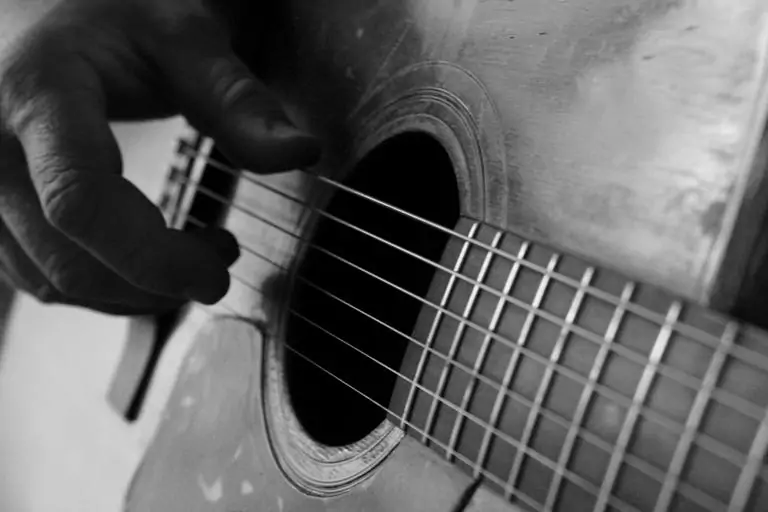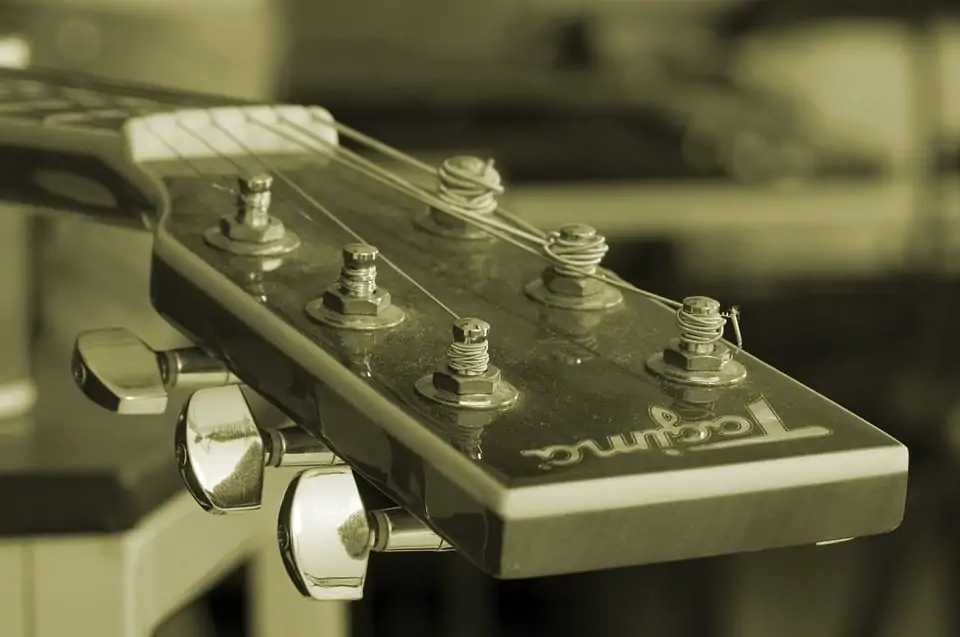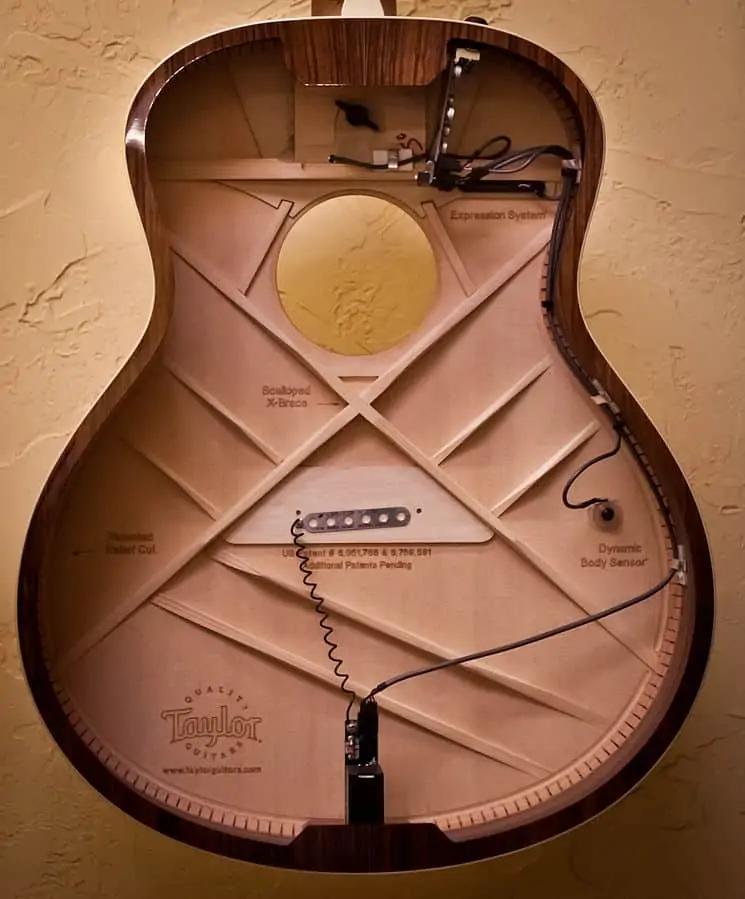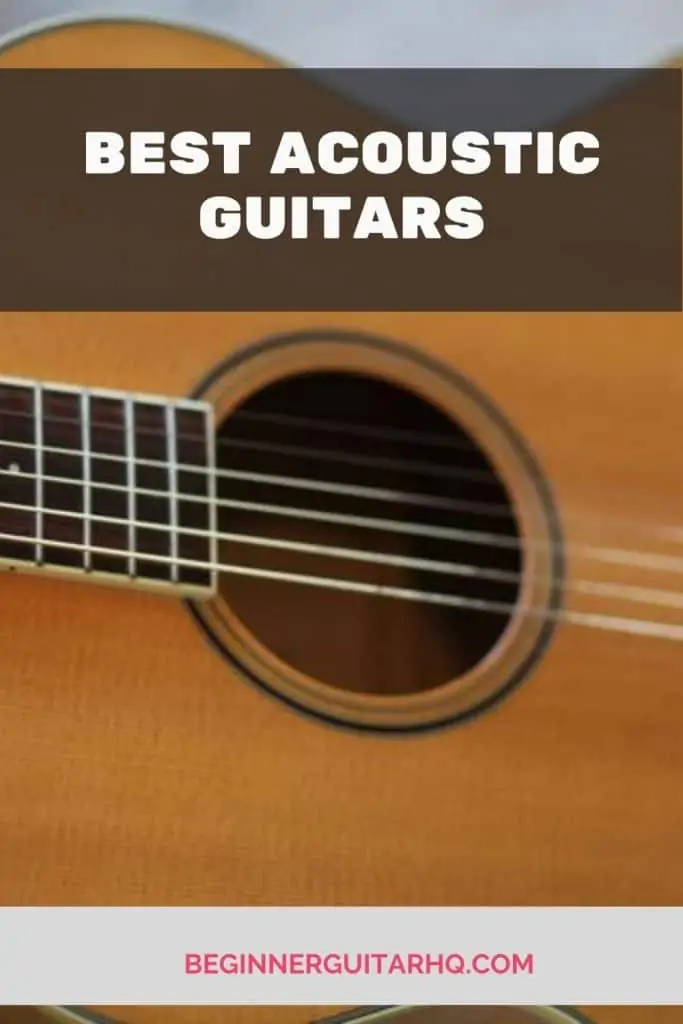Today’s article is reviewing the best acoustic guitars under 1000. Naturally, we’ve included various premium choices without breaking the triple-zero price mark.
At the same time, we included budget and mid-tier options as well. The best way we found to create the list was climbing the price ladder with each item, so you see what changes and the extra quality you get for the extra investment,
Because we’re reviewing fairly expensive acoustic guitars, we’ll start the article with a comprehensive acoustic guitar buyer’s guide. We’re covering the essentials you need to know to make an informed decision.
Another thing we should mention is electronics. When someone says “acoustic guitar,” they might refer to a fully acoustic instrument or an acoustic-electric. We’re including both types of guitars in our article as we don’t know what you might prefer.
In general, you can play live and record with your acoustic guitar by using a proper microphone. For example, in a live scenario, you’d need a PA System, which is the combination of a mic and a speaker. For recording the guitar, you’d need, for instance, a condenser mic.
Moreover, songwriters and hobby players would prefer an acoustic guitar. The presence of electronics is otherwise a good choice for performers and solo performers, and while you can still amplify an acoustic-electric guitar with a mic, you could also do it with an acoustic amplifier.
Acoustic amplifiers offer you the possibility of using acoustic guitar pedals for extra versatility and experimentation and equalization, which tends to be better and more reliable. Also, acoustic-electric guitars allow you to use advanced electronics like loopers and acoustic/voice effect pedals.
You may choose according to your needs and current setup. If you’re looking for some extra gear, you may also check the articles we’re pointing at for further information.
Top-tier acoustic guitar brands include Taylor, Takamine, Fender, Yamaha, and Martin.
Some extra tips we have for you is our guide on how to choose an acoustic guitar. Similarly, here’re 11 factors to consider before buying an acoustic guitar.
Contents
Acoustic guitars buyer’s guide: initial considerations
Choosing an acoustic guitar can be difficult because there’re plenty of brands and options out there.
There’re body designs, styles, tonewoods, shapes, sizes, and electronics to consider. We’re explaining each of these factors.
First, though, let’s get something clear…
Acoustic guitars are hollow-body instruments. The construction material is wood, although other less common materials may include glass, fiberglass, carbo, plastic, metal, and bamboo.
The construction relies on the body, which is where you’ll find the soundhole. Particularly, quality guitars have a bracing pattern within the soundhole. A bracing pattern means geometrically placed pieces of wood within the soundhole to improve sound balance and stability.
You’d also find six strings on the body. Tuning is EADGBE, from low to high. You can also use a “Drop D” intonation, which means down-tuning the lowest string to a D, but not all guitars, strings, or tuning pegs can hold it.
Budget
Acoustic guitars are popular, versatile, and easy to learn. Oftentimes, an acoustic guitar is a go-to instrument to learn how-to-music, much like a keyboard. It’s fun to play, easy to carry, and there’re plenty of valuable budget alternatives.
For these reasons, the acoustic guitar is such a coveted instrument for beginners. Also, proper care can make any acoustic guitar play for a lifetime. On the contrary, electric guitar’s will always suffer degradation at the circuit level.
Having said that, your initial consideration is your budget, needs, and experience. I don’t have to explain any further, but I can recommend you not to skimp on the instrument just to save a couple of bucks.
Even if you’re a beginner, if it’s in your possibilities, don’t go for the cheapest guitar you see. Bear in mind investing, for instance, fifty dollars more can yield a guitar league better than a budget one. And a better guitar lasts longer and allows the player to grow with it.
If you’re an experienced player, there’s not much to say, either. You may jump straight to the reviews in case you don’t need the extra information.
However, a beginner player should read along. Choosing a top-value guitar that offers easy playability is crucial. It makes the experience less frustrating and more enjoyable.
There’re plenty of budget acoustic guitars out there, but most of them come from unbranded and mass-production factories we don’t recommend.
Types of acoustic guitars
The three types of acoustic guitars are archtop, flat-top, and 12-string models.
Flat-top is the one you see everywhere. They simply have a flat-top soundboard and serve most music genres.
Archtops have an arched-top, typically carved with maple. They may be acoustic, acoustic-electric, hollow-electric, semi-hollow electric, or electric, and they mostly play jazz, blues, alternative rock, indie, rockabilly, and similar. These guitars come with f-shaped holes and curves on either side of the body.
Lastly, 12-string guitars have 6 pairs of strings tuning like so: the E and B pairs are tuned in unison; the lower strings, G, D, A, and E, are tuned in octaves. We’re not reviewing these models in this article, though, as we’ve already chosen the best 12-strings acoustic guitars you can buy.
Either way, you should know 12-string guitars are popular for country, rock, pop, and experimental music. They are also a great tool to cover music and original OSTs as follows:
Needless to say, these guitars are a challenge, in particular, because the tunning is pretty delicate and the size is quite hefty. Playing a simple barre chord on a 12-string is a respectable task.
Also, 12-string models are good for strumming and arpeggios, but not solo parts or, much less, guitar lines that require extra effects.
Guitar strings
It’s somehow common to label non-electric guitars as acoustic guitars, but there are some distinctions to recognize.
Acoustic guitars have steel strings. These are the popular ones, common in country, pop, rock, folk, and you-name-it music genres.
The other kind is guitars with nylon strings, which are traditional classical or flamenco guitars.
Choose the right type of guitar according to the music genre you’d like to play. If you’re more of a modern-music person, choose a steel-string guitar. Both kinds are as easy to play and learn with.
Also, putting nylon strings on an acoustic guitar or vice-versa might damage the instrument. This happens because nylon strings handle less tension than steel strings, so you might damage the tuning pegs, the bridge, or even the neck by messing around with the tension.
Acoustic guitars buyer’s guide: construction and design
Let’s break down the construction of an acoustic guitar so we can go on towards the tonewoods.
The neck
The neck is attached to the body. It’s curved on the back to fit your hand, and flat at the top, where the fingerboard is.
Most guitars have a set neck, which means the neck is glued to the body. Others come with a bolt-on neck, which means the attachment is made with bolts. It’s not very common on acoustic guitars, though.
An important element to find here is a truss rod. A truss rod is a piece of wood or steel that runs inside the neck to prevent bends from string tensions. You can adjust a truss rod to fix the string height, buzzing, and intonation issues, and you can access it either from the nut, commonly.
Then, there’s the fingerboard, divided by metal fret markets. Moreover, there’re fret dot markers on the 5th, 9th, and 12th fret. These markers make it easier for you to travel up and down the neck.
The headstock
At the end of the guitar, there’s the headstock. It holds the tuning pegs, which differ in quality. The best kind of tuning pegs is known as locking tuners.
You want the tuners to be smooth and capable of holding intonation. If you get the opportunity to try a guitar, bend a few strings and see if it holds the tune correctly.
Then, the nut attaches the headstock to the neck. It’s a small strip of plastic, bone, metal, or synthetic material. It also keeps the strings in place. That said, the length of the strings goes from beneath the nuts to the bridge, on the guitar’s body.
The body
First, you’d find the bridge, which supports the strings and transmits the string’s vibrations to the soundboard. It’s an essential piece that fits the strings into holes and keeps them in place with bridge pins.
On the bridge, you’d find the saddle or the saddles. These are thin strips of wood, steel, or plastic on the top of the bridge. They hold the strings in correct alignment across the neck.
Then, there’s the soundhole at the center of the body, and beneath the soundhole, there’s a bracing pattern on quality guitars.
The bracing might have an X pattern or a ladder pattern. The X pattern is the most common for acoustic guitars, and it comes from Martin guitars. It relies on two braces forming an X inside the guitar, on the top and sides.
A ladder bracing uses horizontal braces running from one side to the other. It supports the back of the guitar and creates greater outputs. At the same time, it creates old-school sounds.
Another factor to consider is the rosette atop the soundhole. It refers to the aesthetic details decorating the area.
Also, you should know the sides and the back of the guitar’s body are part of the chamber. The lower portion is the bout, and the curve is the waist.
That said, most guitars feature a pickguard. This is a material (commonly plastic) that protects the top of the body from pick scratches.
Taylor Guitar Insides by Richard, CC BY-SA 2.0Bracing systems provide integrity to the structure. It also affects the guitar’s sound and helps keep the sound vibrations focused and controlled.
Body styles
Acoustic guitars come in five different choices, on top of different cutaway styles.
The styles range from full-sized guitars to “short-scale” bodies.
In that regard, a guitar’s size is referred to as “scale length,” which means the length of the strings from nut to bridge. The typical scale length is 25.8’’.
- Concert and grand concert acoustic guitars: these are medium-sized guitars with slightly deep and balanced tones. The tone sounds similar playing either with your fingers or picks. Also, these are comfortable to play for younger and smaller players as they are not as big as the name implies.
- Auditorium, and grand auditorium acoustic guitars: these are also medium-sized guitars with a warmer but yet balanced tone. Its size offers more protection than concert guitars, albeit they are only about one inch larger than concert acoustic guitars. Moreover, these models have a deeper waist to sit the guitar on your lap.
- Dreadnought acoustic guitars: by far, dreadnought guitars are the most common and popular models, and they also come from Martin. These have the same size as auditorium guitars but with a shallower waist and bolder, bigger sounds.
- Jumbo acoustic guitars: these are the largest models, and they produce resonant and rich tones, also with a bigger projection. However, their size makes it uncomfortable for most players.
- Travel guitars: these are shorter guitars as they are designed as on-the-road instruments. Hence, travel guitars are easy to carry and lightweight. They also have thinner fretboards, shorter bodies, and thin sounds.
- Parlor guitars: lastly, there’re fewer than fully-sized guitars, which are known as “parlors.” These may have ¼, ½, or ¾ of the scale length. In essence, these guitars have shorter necks and thin bodies intended for children. It has just enough frets to learn guitar without being overwhelmed. Children 10+ years old should use a fully-sized guitar instead of a parlor.
Another factor to name is the “12-fret” and “14-fret” nomenclature. It refers to the number of frets before the neck meets the body.
Cutaways
The term refers to the cutout on a guitar’s body where the neck meets the body. A lower cutaway gives easier access to the treble side of the higher frets; an upper cutaway gives easier access to the deeper side of the highs.
Most dreadnoughts, for example, come with a lower cutaway, which is generally good for all styles of music.
However, not all guitars have cutaways, so consider this before you buy a guitar.
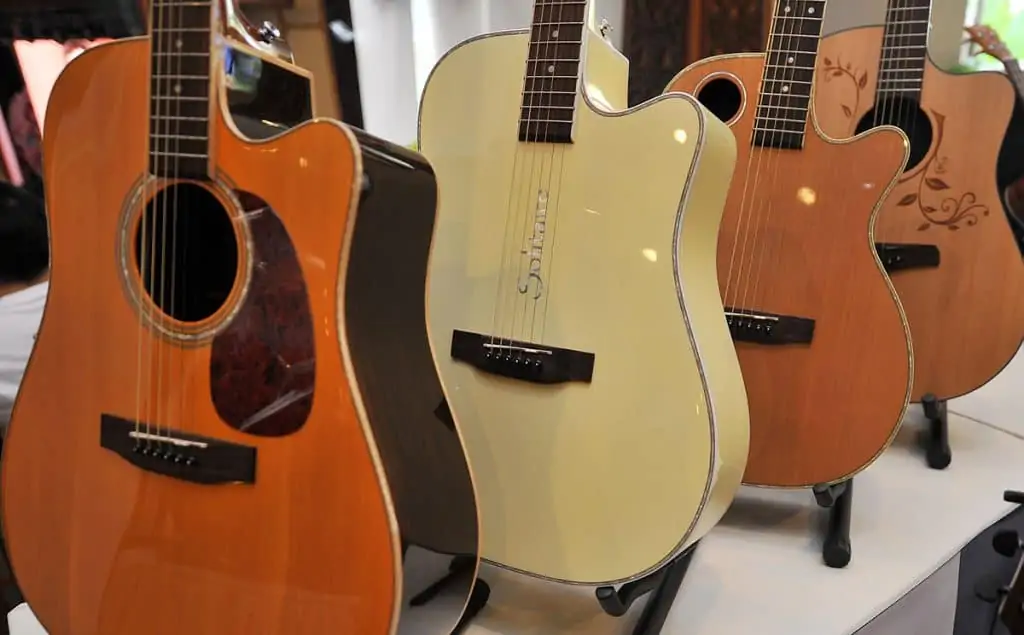
Tonewoods
The tone signature and sound projection of a guitar depends on the tonewoods, which are the construction materials.
Most acoustic guitars have up to three wood types. There’s one for the body, which is commonly the same as the neck. Then, there’s another tonewood for the fingerboard. And, finally, there’s a tonewood at the top of the body, which is the one that influences the sound the most.
Also, the wood on top may be repeated at the back and sides of the body as laminated pieces of wood.
That said, tonewoods may come as laminated pieces or solid tops. A solid top has solid pieces of wood. Laminated woods feature several layers of wood pressed together, and while they save money, the sound quality is not as good. Lower price brackets can’t afford solid top bodies, though.
Now that we know, let’s see the different wood types:
- Spruce: is a common material for acoustic guitars. It’s tough, lightweight, and durable. As for sound, it offers a well-balanced tone that improves as the wood matures. Thus, an old spruce guitar sounds warmer and fuller.
- Sitka spruce: is the top choice for most USA guitar manufacturers. It’s light and strong, and it provides a complex, harmonious tone. It also improves over time.
- Adirondack, Engelmann, and Lutz spruce: these are less common materials found in high-quality guitars. In essence, they represent an improvement over regular spruce.
- Rosewood: it’s the favorite choice for fingerboards as it’s naturally oily and soft. It also produces rich and warm tones with a great projection. Previously, Brazilian rosewood was the go-to choice, but due to deforestation, today’s choice is Indian rosewood.
- Mahogany: it’s one of the best choices and the only tonewood that works on any part of the guitar. It’s dense and lightweight, and it produces warm highs, deep lows, and superb volumes. In particular, the reputed Martin D-15 is an all-mahogany guitar.
- Walnut: it’s also a dense wood that procures a tone similar to mahogany, only richer and softer. However, the wood becomes richer as it ages.
- Maple: it offers transparent tones, eye-catching natural grains, and durable bodies. It’s a common choice for the backs, sides, and arched tops. Also, its sound can easily cut through any mix.
- Cedar: it’s a softwood that produces mellow tones.
Finishes
The final touch of any guitar is the finish, which protects the woods, adds aesthetic qualities, and affects the sound.
For example, too much finish clogs the fibers of the wood, whereas too little leaves the guitar unprotected from rust and dust.
What we like is an all-natural finish that allows the guitar to vibrate and breathe freely.
Either way, these are the options you’ll find:
- Lacquer: it’s a classical material that creates a shiny gloss. It’s easy to clean, but it reflects nicks and dings.
- Shellac: it’s a durable finish that seals the wood against scratches and damages.
- Varnish: it enhances the natural grain of the woods with less gloss. Also, it doesn’t reflect dings or scratches, albeit it’s not as durable as other finishing options.
- Satin: it’s the most common option. It’s a natural material that reflects light and makes the surface smoother.
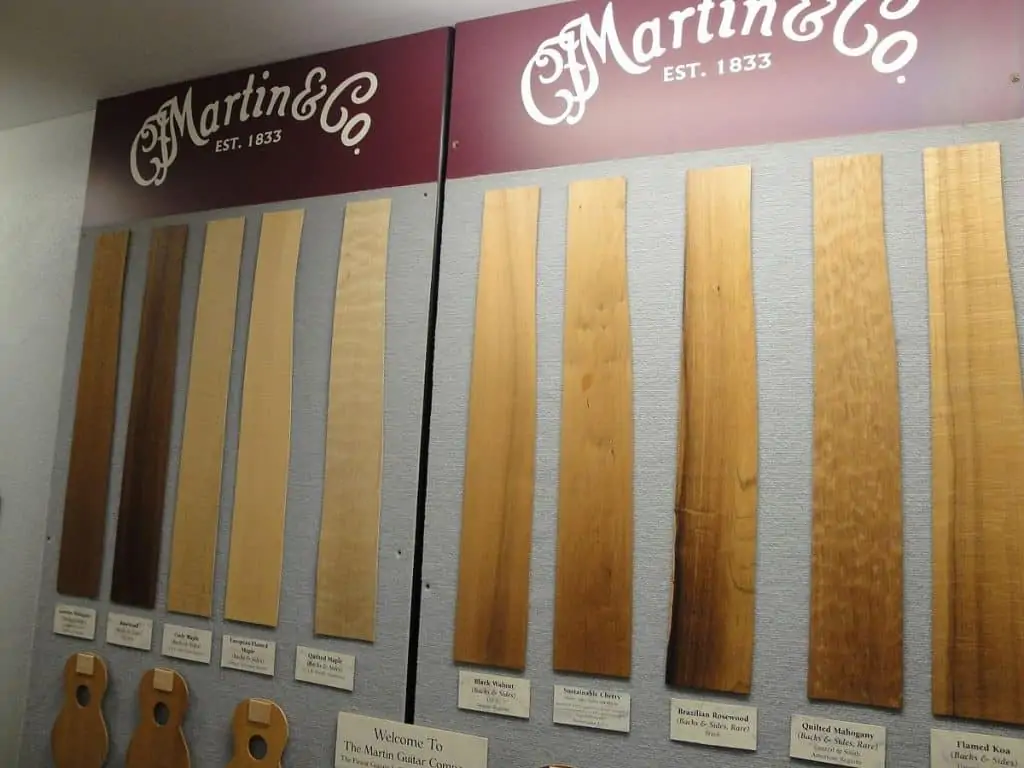
Acoustic-electric guitars
The last part of our buyer’s guide details the extra power acoustic-electric guitars have. These instruments have a pickup system, a pickup beneath the soundhole plus an EQ section at the sides.
Generally, acoustic-electric guitars are better for live performing as you get extra options to equalize the sound. This is a much-needed feature for rooms and scenarios of different sizes.
That said, the preamp tends to bring EQ options, volume controls, and built-in tuners.
As a general rule of thumb, choose an acoustic-electric for playing live; for hobby playing, songwriting and recording, an acoustic works better. That’s because the best possible sound you can get from a guitar comes from the microphone, not from an amplifier.
Acoustic-electric guitars still have enough natural resonance to fill a room and small living rooms, but nothing else.
Top 10 best acoustic guitars under 1000 reviews
The following section is reviewing the top 10 acoustic guitars under 1000. Please consider your experience level, your budget, and your needs to pick the right model for you.
At the same time, consider a pricier guitar is not always better. An inexpensive guitar might be best for its sound and performance, while the pricier one might only deliver a better “logo” and extra aesthetic features.
Best overall acoustic guitar: Seagull S6
The Seagull S6 is a premium Canadian electro-acoustic guitar selling for a mid-level price. Lucky for you, the only thing keeping it from being a thousand-dollar guitar is its brand, as it comes from a relatively small company compared to Fender, Gibson, Takamine, or Taylor.
Either way, it’s a distinct Concert guitar, and that’s because the company prioritizes quality over aesthetics. These are not empty words, though: Seagull guitars are hand-crafted and pack original blueprints from the company’s luthiers, creative, and creators.
First off, the body has a solid cedar construction with Canadian Wild Cherry at the back and sides. That’s an exotic choice with a superb natural finish for extra protection.
Moreover, it has a pressure-tested cedar top for a unique, elegant, and warm tone that gets better as the guitar ages. The rest of the materials include a rosewood fret plus a Wild Cherry neck.
The compound curved top is slightly arched above the soundhole, which allows a thin and light bracing pattern at the top. This delivers a powerful and stable sound with extra projection.
That said, it has a Sitka Spruce bracing carved into the sides of the guitar. It provides strength to resist string tension without adding any extra weight. At the same time, it allows the strings and the bridge to vibrate freely.
For playability, it has a flat neck, which is not very suited for beginner players as your hands won’t easily wrap around the piece. Classical guitarists, however, could feel at home with the S6 model.
Other elements include an ice-lolly-shaped headstock that keeps the guitar straight and the intonation in check; and a high-quality bridge, saddles, and nut.
In Particular, it has six individually compensated saddles. That means each saddle grooves and vibrates with the string to maintain sustain, resonance, and intonation.
Another element to find here is an advanced truss, which you can adjust to raise or lower the strings to your liking.
As you see, everything about the S6 is premium and advanced. Only a short selection of guitars adds this sheer amount of design features and premium tonewoods. You can read the full list of design choices here.
In summary, the Seagull S6 sells for a mid-level price and sounds like the most expensive guitar of any store.
Take a look at how it sounds and make your conclusion:
There’s an acoustic-electric version of the Seagull S6, which is the Seagull S6 Slim QI. It’s a dreadnought guitar with a pronounced lower cutaway and Godin Quantum electronics.
However, most players would prefer using the Seagull S6 with a PA system or a mic instead of the electrified version.
Best beginner acoustic guitar: Jasmine S35
The Jasmine S35 kickstarts our list as the best cheap acoustic guitar there is. It’s suited for beginners, but with a good enough sound for all players on a budget.
It’s a dirt-cheap guitar providing great value. Against similarly priced competitors, it sounds and feels significantly better, so much so that you could use it for recording and live performance.
Furthermore, the guitar sells with a bundle, making the package even better. The bundle includes a strap, picks, a tuner, a cleaning cloth, a carrying bag, and a lessons DVD.
The construction is flawless, although it uses laminated pieces on the body. In particular, it’s mahogany for the body with laminated Sitka Spruce at the top and laminated Nato at the back and sides. Then, it packs a nato neck and rosewood on the fingerboard.
As for design, we’re looking at a Concert acoustic guitar with a slimmer body and no cutaway. That makes it appealing for beginners as it’s quite easy to play.
A surprising feature of the guitar is its “Advanced X-bracing pattern, plus a slim neck for fast playability. The first choice delivers an incredible output, whereas the second allows easier access to the higher frets, even if there are no cutaways on the body.
Overall, if you’re looking for a reliable guitar to start your journey, there’s hardly anything better than the Jasmine S35. Bear in mind Takamine is the original designer of the guitar, so the blueprint ensures quality tone, a rich acoustic tone, and a balanced sound.
Take a peek of how it sounds:
Best budget acoustic guitar: Epiphone DR-100
The Epiphone DR-100 is a dreadnought guitar without a cutaway, a mahogany body, and a select Spruce top.
For the neck, Epiphone also uses mahogany, and it pairs the construction with a classic rosewood neck. That said, the combination between the mahogany neck and the body tonewoods creates a layered tone with richness, roundness, and depth.
It all comes together with a nice satin finish and careful construction. The guitar looks and feels much like most dreadnought guitars. However, it does so on a budget and with an impressively good sound.
Overall, the construction delivers more than what you expect from a budget guitar, excluding of course the Jasmine S35. However, compared to the S35, the DR-100 is more geared towards experienced players due to the dreadnought body and SlimTaper neck (the same shape Gibson and Epiphone electric guitars have).
At the same time, these features are beginner-friendly, so players of all categories can enjoy the Epiphone DR-100.
Best budget acoustic-electric guitar: Yamaha APX600III BL Thin Body
The APX600III is one of Yamaha’s best-selling guitars, and that’s not a minor thing. Coming from one of the top-tier guitar manufacturers, the APX600III packs advanced electronics and proprietary technology to make itself distinct from its competitors.
It’s still an “entry-level” electro-acoustic guitar, though. That means we don’t recommend searching for these models on lower price brackets. That said, the APX series features custom Yamaha pickups, a custom preamp, a unique oval shape for the soundhole, and a proprietary bracing pattern as well.
As a result, the tone comes out dynamic, powerful, and responsive. In particular, its scalloped bracing pattern enhances the bass frequencies to make the guitar fatter and more serious. Similarly, the oval soundhole thickens lower-mids for a more open low-end sound.
As for tonewoods, it has a solid mahogany piece at the body with a spruce top and mahogany at the back and sides. Then, it has a mahogany neck and a rosewood fret.
There’s a particular design feature at the frets we need to mention. The spacing between the frets is narrower than standard 25.6’’ guitars because the APX600III has a 25’’ length scale construction. For electronics, it has a Yamaha piezoelectric pickup
For electronics, it features a Yamaha SRT transducer, an under-saddle piezoelectric pickup of the reputed A-Series range. It delivers a natural tone while rejecting feedback. Also, it can easily cut through any mix.
The preamp comes in the form of Yamaha’s A.R.T system plus a multi-layer construction featuring quality materials. More importantly, the ART system is about recreating the best possible conditions of the wood to deliver the best possible sound.
That said, the guitar comes with a built-in tuner, and 3-band EQ.
Rounding up the hardware combines a quality fixed bridge and solid open-gear tuners.
Overall, the Yamaha APX600III is a top-value acoustic-electric guitar. As you see, it packs a ton of unique features for an affordable price, which is way more than most brands can offer.
And for the sound, it’s clear, resonant, bright, and gentle.
If you can’t find the Yamaha APX600III guitar, there’s also the APX600 BL, another bestseller. It’s the same guitar, in essence, as it only has a couple of aesthetic differences.
Best-selling acoustic guitar: Yamaha FG800
We need to speak about one of the most popular acoustic guitars in history as well, which is the Yamaha FG800.
The 800 series dates back to 1966 as budget solutions for experienced and beginner players alike.
The series puts performance over other values and delivers promise with a classic dreadnought body with no cutaways.
Its magic begins at the construction quality, where you’ll find a Yamaha-designed scalloped bracing pattern in the soundhole to create a unique tone signature.
Additionally, it features solid wood construction, which is impressive at this price range. For tonewoods, it has solid Sitka Spruce at the top, Sitka Spruce bracing, a mahogany body, and laminated Okoume/nato for the back and sides.
The nato neck has a standard shape with a satin finish. Notably, Yamaha hand-sprays these guitars during the finishing process for a better result. Similarly, it has a rosewood fretboard.
The bridge, saddles, nut, and tuning pegs are decent, but they could be better. Lucky for you, changing these pieces is cheap enough and may deliver significantly better results.
Best value acoustic guitar: Fender CD60SCE
The Fender CD60SCE is an affordable Fender acoustic-electric dreadnought guitar. It’s simple, though, nothing like the APX600III from Yamaha. Still, it packs the Fender logo and the brand’s attention to detail and design quality.
In essence, the CD60SCE is a no-nonsense electroacoustic guitar that serves as a solution for beginners and players on a budget. It’s also a popular model, and that’s because of its price, performance, and brand.
As a Fender guitar, it has a quality X-bracing pattern and a Fishman Isys III pickup system for a nicely rounded sound. Compared to other guitars at the same price bracket, the CD60CE has extra beef and output. Plus, the tone comes out fairly balanced, clear, and easy to work with.
For materials, it has mahogany at the top with laminated mahogany at the body, back, and sides. It also has mahogany at the neck plus a rosewood fingerboard.
Speaking of quality construction, the guitar packs reliable hardware as well. For example, the die-cast tuners can hold their ground on live presentations, whereas the fixed bridge enhances sustain and resonance.
This is a Fender instrument through and through. Even though it has laminated wood pieces, it’s an instrument coming from a top-tier brand that doesn’t break the bank. It’s good-looking, easy to play, and fun.
In summary, the Fender CD60SCE is an easy pick. As an all-rounder guitar, you can trust it will work for you.
The Fender CD60SCE is the electro-acoustic version of the Fender CD60, featuring a similar construction and sound.
Best mid-tier acoustic guitar: Takamine GD30CE-NAT
Takamine is a reputed Japanese guitar maker. They are known as a top brand, and their forte is creating premium guitars to sell for fair prices with an impressive mix of cutting-edge tech and classic craftsmanship.
Let me explain further. They mix AI-guided processing with the careful hand of a luthier to create all the guitars. That delivers flawless instruments that could easily outperform most of their competition.
For example, they use a vacuum press to apply uniform pressure on the struts; or a laser-guided process to smooth out the fingerboard. At the same time, luthiers create the bracing, the finish, the hardware installation, and the aesthetic details of the guitar.
Such combinations between old and new construction methods are Takamine’s signature.
That said, we chose their Takamine GD30CE as the best mid-tier model you can buy right now. It’s a dreadnought guitar with a lower cutaway, a quality scratch pick, and top-tier hardware.
This guitar has a solid Spruce top, mahogany on the back and sides, and a solid mahogany body. As you’d expect, this tonewood combination produces rich and resonant sounds.
Then, it packs a slim mahogany neck with the “standard”12’’ radius. And by “standard” I mean the measures you’d find on a Gibson guitar, for example, so aggressive shredders and rock players could love the GD30 model.
It also packs electronics, although its bold sound is enough to use on a PA system. That said, it uses a Takamine TP-4TD preamp, which packs a 3-band EQ, gains controls, and a built-in tuner.
All of these come with an elegant natural gloss finish and a stylish design.
As for the sound, it’s bright and happy with a bit of warmth and low-end fatness. It also feels as if it had texture. Overall, it sounds premium.
Best classical acoustic-electric guitar: Yamaha NTX700
Because it’s a classical guitar (with nylon strings), the Yamaha NTX700 falls in the popularity bracket. Still, it packs a great deal of quality for its mid-tier price. It also mixes classical sound with the modern advantage of electronics.
As a unique nylon-string acoustic-electric dreadnought guitar, the Yamaha NTX700 features a premium sound either plugged or unplugged. As you’d expect, though, the sound leans towards jazz, blues, indie, experimental, Latin music, bossa nova, and similar genres.
The NX series features flawless construction, solid quality tonewoods, and elegant details. Where it shines, though, is the sound, and that’s because of the proprietary Yamaha pickup system.
It features the same electronic setup as the top-tier NX guitars while losing tonewood and aesthetic choices.
For tonewoods, it has Spruce on the body with a Spruce top and nato on the back and sides. Then, it has a nato neck plus a nato fingerboard.
In particular, the neck is flat and slim for easier chord playing. The design of the guitar feels like a friendly Fender Telecaster, which is known as one of the best, if not the best, rhythm electric guitar there is.
More importantly, it features an ART-2 pickup system with an under-saddle piezoelectric pickup. And, as for the sound, it’s natural, dynamic, clear, deep, and elegant, the most elegant a Yamaha guitar could sound.
And, also, this guitar is gorgeous.
Best parlor guitar: Taylor GS Mini
The Taylor GS Mini comes with a small body but bold sound. Because of that, it’s the best acoustic guitar to use at home for songwriting or recording.
Taylor sells it as a bridge between travel guitars and fully-fledged, premium models. That makes it stand at the top of the market for what it is, with few guitars capable of delivering a similar promise.
In essence, the GS Mini is a smaller version of the Taylor Grand Symphony, but with pickups. And much like the original model, the GS Mini is the do-it-all guitar. It has plenty of volume, fair versatility, thick treble, present mids, and smooth lows.
There’re versions with koa, mahogany, or walnut bodes. I shared the koa version as it seems to be the most popular one. This version has a solid koa body with laminated koa at the back and sides. It then packs an ebony fingerboard plus a mahogany neck.
To compensate the output with the small size of the guitar, Taylor included the X-bracing pattern they use for their classical, nylon-string guitars. Because nylon strings create less energy and tension, the tops of these guitars are lighter and thinner, and thus they use thin woods to create the bracing.
All of this brings a distinct sound signature reminiscent of a ukulele if you will. It is not, though, it’s much more serious. The voice is open, responsive, open, and powerful in terms of sustain and vibration.
Elsewhere, it brings Taylor electronics in the form of an under-saddle ES2 pickup, and a 2-band EQ preamp. There’s nothing special to this, but it can amplify the sound in the most natural way possible. It changes nothing while retaining all of the natural qualities of the woods.
Best premium: Seagull Performer HG QI
You can expect the Seagull Quality on this premium guitar as well. In this case, though, it’s a guitar with flamed maple at the back and sides, and a solid spruce top.
It has the same Select Pressure Tested top, unique bracing pattern, and tapered headstock design.
This time around, it adds a custom polished high-gloss finish and Quantum IT electronics for a top-tier aesthetic and sound.
Its preamp includes a built-in tuner, a 3-band EQ, and a volume knob. It’s quite versatile and ready to play live.
Design-wise, the Seagull Performer series are dreadnought guitars with a 3-ply hardwood laminated body. It might sound underwhelming, but Seagull chose it for a reason: it compensates the weight of flamed maple at the back and sides.
Also, the guitar has an integrated set neck. This is a technique seen in premium electric guitars but very uncommon on acoustic models. It means fitting the body and the neck together with a tight and precise mortise-and-tenon joint, or a dovetail joint.
Other details include flame maple veneer headstock plus an included traveling bag.
As for sound, it’s clear, powerful, bright, and with enhanced trebles to cut through any mix.
Bonus: overpriced but amazing acoustic guitar: Taylor 110e
Perhaps you wouldn’t see the price of the Taylor 100e Dreadnought guitar and think “oh, yeah, men, that’s a mid-tier price.” Hear me out, though…but Taylor sells it as a “starter Taylor guitar,” would you believe?
There’s still plenty to find here in terms of quality, performance, and sound. Whereas I consider the Seagull S6 as a better guitar, the 110e is impressive on its terms. Maybe just a bit pricier than need be.
What I dislike about the guitar is its laminated walnut body, which is not something I welcome at this price range. And although the construction is flawless and the sound is good, we recognize there’s a hefty overprice simply for the logo on the headstock.
Still, if you’re an intermediate player and money is no problem, you can go ahead for the Taylor 110e. It’s an example of a company doing everything perfectly.
Particularly, the Expression System 2 is ideal for live performance, and, being this a Taylor guitar, the quality is all across the frequency board.

